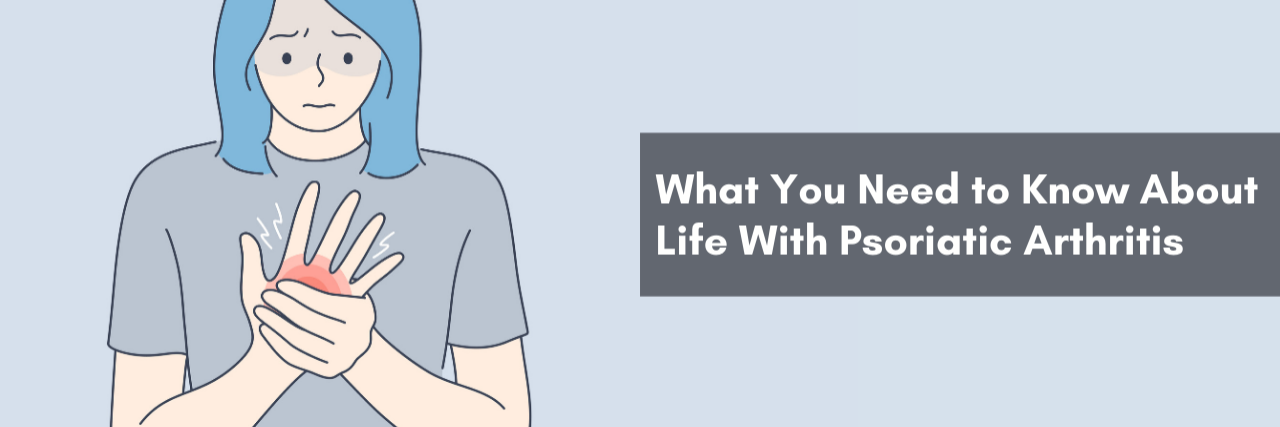You’ve probably heard of arthritis, and you may be familiar with psoriasis. But did you know there is a condition called psoriatic arthritis? People living with PsA can have the rash of psoriasis, along with an accompanying form of arthritis. It is a lifelong condition, which affects about 1.5 million Americans. I have been living with PsA for more than 12 years. Here is what you need to know about life with PsA.
It’s not your grandmother’s arthritis…
When most people hear the word arthritis, they picture an elderly person’s hands, knobby and misshapen. They are probably envisioning osteoarthritis, which is a slowly deteriorating joint disease that causes the cartilage in the joints to break down. It is more common in older people due to the years of use their joints have had. Psoriatic arthritis (PsA) is a form of rheumatoid arthritis, an autoimmune disease that causes inflammation of the joints and often affects multiple organ systems and body parts.
In PsA, many patients first develop psoriasis, which can be itchy, red patches on the skin, silvery scales or misshapen, pitted nails. Joint pain, swelling and stiffness, especially upon waking, are signs that the disease has advanced. Studies show that 30% of people who have psoriasis will also develop PsA. It can affect any age, but it is most common in men and women between 30 and 50 years old.
…but it could be your kid’s.
Twenty-some years ago, I had never heard of PsA. I was familiar with psoriasis, however, because my 10-year-old son had the itchy, scaly patches on his scalp, legs, arms and hands, as well as the tell-tale pitting of his nails. When he started complaining of joint pain and stiffness, we went to see a rheumatologist in a large children’s hospital, where the doctor diagnosed him with juvenile PsA. These days, a child with PsA is known to have juvenile idiopathic arthritis, which means the cause of the disease is unknown. He explained that it was rare, but not unheard of, in children. Experts believe 1-10 in every 33,000 children has juvenile PsA, with most diagnoses made between 6 and 10 years old. Children don’t usually outgrow this condition; it tends to go into remission and return later in life as an “adult” version.
It’s more than skin and joints.
Besides joint pain, swelling and skin symptoms of PsA, there are many other issues that can occur and cause trouble. Some people have foot pain at the back of their heel (Achilles tendinitis) or the sole of their foot (plantar fasciitis), while others might have lower back pain (spondylitis) caused by inflammation to the joints between the vertebrae. The eyes are another area that can be affected by PsA. Some patients often have conjunctivitis (pink-eye) or uveitis, which can cause painful red eyes and blurry vision. Your ophthalmologist should be made aware of your PsA, even if your eyes aren’t bothering you.
Many people with PsA report a reduced quality of life due to additional factors, such as debilitating fatigue, depression, sleep disorders, work impairment and decreased joint mobility. I feel like no body part or system has been unaffected by PsA. Other than the joint pain, fatigue has been my most challenging symptom. It’s not the kind of tiredness that a good night’s sleep or a nap will cure. It is an all-encompassing body exhaustion that sometimes makes it hard, if not impossible, to get out of bed in the morning. There are many Mighty stories that describe this kind of fatigue, because it is common to many chronic conditions.
There are comorbidities.
Along with affecting different body parts and systems, PsA is associated with many other health conditions called comorbidities. In fact, more than half of people with PsA have at least one other condition, and 40% have three or more. Some common comorbidities are cardiovascular disease, obesity, type 2 diabetes, metabolic syndrome, non-alcoholic fatty liver disease, inflammatory bowel disease and lupus (SLE). It’s important to make all of your healthcare providers aware of your PsA; what may seem like an unrelated symptom could be a progression or change in the disease.
There is no cure, but there is lots of hope.
It’s important to seek support from a rheumatologist when the joints are affected. While neither psoriasis nor PsA has a cure, there are many treatments available that can ease the symptoms, and patients are most successful when treated early. Today’s treatments can slow disease progression, ease pain, preserve mobility and protect your joints. Most treatments will also reduce the appearance of the rashes and nail damage. The science is very exciting; new and improved medications seem to be coming down the pipeline all the time.
Scientists are working very hard to find ways to treat PsA and alter the disease’s progression. There are many promising studies that suggest potentially life-changing drugs in the future. In the meantime, talk with your doctor to find a treatment option that works best for you. Life with PsA can be painful and hard, but there is hope.
Sources
Haddad, Amir, and Devy Zisman. “Comorbidities in Patients with Psoriatic Arthritis.” Rambam Maimonides Medical Journal, vol. 8, no. 1, 2017, p. e0004. doi:10.5041/RMMJ.10279.
Mease, P. J. “Prevalence of rheumatologist-diagnosed psoriatic arthritis in patients with psoriasis in European/North American dermatology clinics.” Journal of the American Academy of Dermatology, vol. 69, no. 5, 2013, pp. 729-735.
Sherry, David D. “Juvenile Idiopathic Arthritis.” Medscape, 5 January 2021, emedicine.medscape.com. Accessed 11 2 2021.

